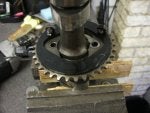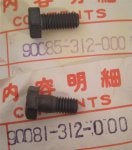I just did a Cam Bolts torque test. The CAM BOLTS were used at least twice, total extension length (torque wrench to end of socket) 7 inches, bolts and threads Dry.
I have beam and a click type torque wrenchs, they are closely matched. I used the clicker type.
Both Bolts felt very solid up to 16 ft. lbs, at 17 the non shouldered bolt was stretching and snapped after another half turn, the shouldered was still very solid at 17, at 18 ft. lbs the shouldered bolt stretched and took about a half turn then broke.
If using loctite (or oily bolts) torque required will be less since they're Not Dry, the book torque is probably dry torque.
Either way the cam must be held solid to torque them (I use vice grips on the thick part of the cam resting against the cam case).
They need to be fully torqued, if one don't feel solid replace it, they're designed to be very tight!
Manual says Camshaft sprocket bolts are 7mm and the specs show torque is 12 to 15 Ft/lbs (per Chilton's)
(NOTE) cam bolts are actually 6mm.. 12 to 15 Ft/lbs seems correct from the test I did.
Make sure you have the correct sprocket for your cam, the K0 (fat cam is different rockers and sprocket from later models)
I have beam and a click type torque wrenchs, they are closely matched. I used the clicker type.
Both Bolts felt very solid up to 16 ft. lbs, at 17 the non shouldered bolt was stretching and snapped after another half turn, the shouldered was still very solid at 17, at 18 ft. lbs the shouldered bolt stretched and took about a half turn then broke.
If using loctite (or oily bolts) torque required will be less since they're Not Dry, the book torque is probably dry torque.
Either way the cam must be held solid to torque them (I use vice grips on the thick part of the cam resting against the cam case).
They need to be fully torqued, if one don't feel solid replace it, they're designed to be very tight!
Manual says Camshaft sprocket bolts are 7mm and the specs show torque is 12 to 15 Ft/lbs (per Chilton's)
(NOTE) cam bolts are actually 6mm.. 12 to 15 Ft/lbs seems correct from the test I did.
Make sure you have the correct sprocket for your cam, the K0 (fat cam is different rockers and sprocket from later models)












